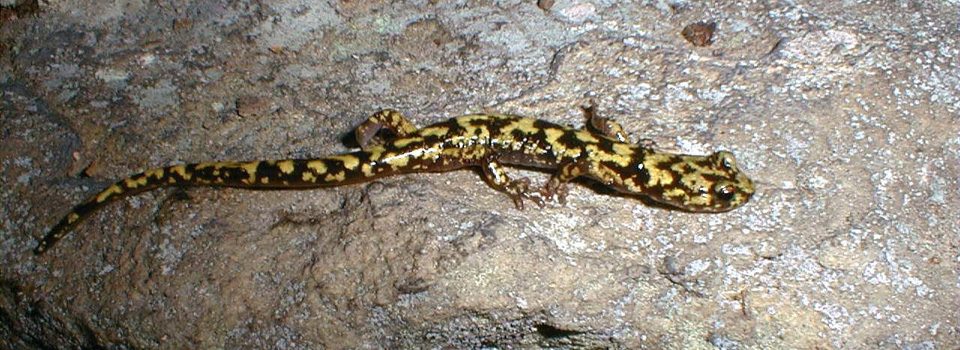
Herpetology
Collections
Amphibian and reptile specimens are archived in a variety of formats at Auburn University. A total of just over 40,000 records comprise these collections. Below, we describe each of the formats from which specimen data are available. To search our collections, please utilize our web portal. Currently, the wet collections are available to search. We are actively working on adding the osteology, tissue and digital voucher collections to the portal. They will be made available here as they come online. Until that time, contact the curator or collections manager if you are in need of data from those collections.
Wet Collections
At total of around 40,000 specimens are stored in fluids in an area dedicated to herpetology. The space meets specifications for fire and blast safety. Because of this, individuals visiting this space must be accompanied by the Collections Manager.
Alcohol Specimens – 39,000 specimens are stored in 70% ethanol and comprise the majority of physical specimens of amphibians and reptiles. The original series of tags carried the label API (Alabama Polytechnic Institute) while the remaining carry the AUM label.
Cleared and Stained – A small number of specimens have been cleared and stained and are stored in glycerin.
Larval – Approximately 500 larval amphibian lots are stored in 6% formalin.
Eggs – Approximately 20 specimens of amphibian and reptile eggs are stored in 6% formalin.
Dry Collections
At total of 1,800 herpetological items are stored as dry specimens in space shared by the ornithological and vertebrate paleontology collections. This shared space may be accessed by contacting a curator or the Tetrapods Collection Manager.
Osteological Collection – Close to 2,000 specimens represent osteological materials representing all or part of an individual skeleton. The majority of these specimens are turtles of the southeastern US collected by Dr. James Dobie.
Dry Skin Collection – a small number of specimens are stored as a dried skins. These skin are incorporated into and are searchable via the osteology database.
National Park Holdings
Close to 300 specimens from national parks of the eastern United States are stored at Auburn. Most come from inventory projects performed by Dr. Whit Gibbons at the Savanna River Ecology Lab. Additional specimens come from samples of invasive species from Everglades National Park taken by Dr. Christina Romagosa and her students, Scott Goetz and Melissa Miller.
AUM holdings include specimens from the following National Park System Units:
- Cape Hatteras National Seashore (CAHA)
- Cape Lookout National Seashore (CALO)
- Castillo de San Marcos National Monument (CASA)
- Chattahoochee River National Recreation Area (CHAT)
- Charles Pinckney National Historic Site (CHPI)
- Congaree National Park (COSW)
- Everglades National Park (EVER)
- Fort Frederica National Monument (FOFR)
- Fort Matanzas National Monument (FOMA)
- Fort Moultrie National Monument (FOMO)
- Fort Pulaski National Monument (FOPU)
- Horseshoe Bend National Military Park (HOBE)
- Kennesaw Mountain National Battlefield Park (KEMO)
- Moores Creek National Battlefield (MOCR)
- Ocmulgee National Monument (OCMU)
- Timucuan Ecological and Historic Preserve (TIMU)
- Wright Brothers National Memorial (WRBR)
NOTE: These materials are on loan from the National Parks Service and any request for use must be made through the NPS.
Tissue Collection
Approximately 2,500 tissue specimens are on file, stored either in 95% alcohol frozen to -80°C or in 95% ethanol at room temperature. These tissues are cataloged in their own database which is cross-referenced to the physical or digital specimen when one exists.
Digital Collections
The museum houses a rapidly growing collection of digital vouchers. The collection is actively curated and includes vouchered :
- Digitized Photos and Slides
- Digital Photos
- Digital Audio Recordings
- Video Recordings
Apart from the digital voucher collection above, the herpetology division also has a series of digital photos associated with our vouchered specimens.
Live Collections
Outreach has been a long-term commitment of the herpetological collections at Auburn University. A live collection, maintained for educational purposes, has been a feature of the overall collection since the Mount era. The live collections are named in honor of Jaime Jenkins, a former Mount student who died in a tragic car accident. Jaime was devoted to educational outreach and a fund established in his honor provides the finances to maintain the current collection.
Teaching Collection
In addition to the above collections, the Herpetological Division also maintains a wide variety of specimens used for teaching and outreach. These specimens form the basis of the lab portions of BIOL 4020 – Vertebrate Biodiversity as well as BIOL 5740 – Herpetology and are often used in outreach and informal educational settings.